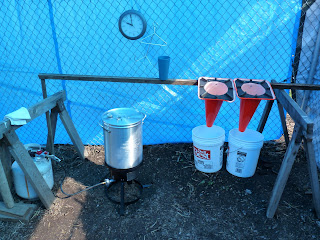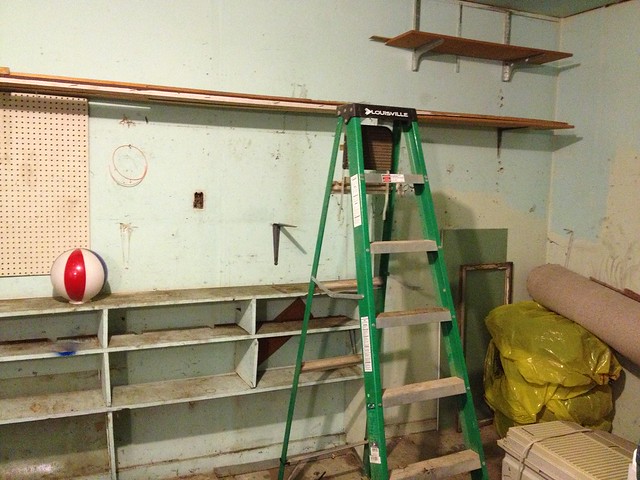So, as many of you know Kelsi and I are very disappointed with the way American meat is raised and processed these days. We decided that if we wanted to continue to conscientiously eat meat we were going to have to take it into our own hands. Truthfully this is much easier said than done. Around the first of March Kelsi and I decided to buy ten Cornish cross meat birds.
We will never buy this kind again. We lost two of them in the first two weeks and the other 8 seemed to be so old, their little legs couldn’t support the massive bodies and only place they were able to walk was to their food and water, other than that their whole days were spent sitting. We hadn’t researched this bird much before purchasing and we definitely learned the hard way that birds selectively bread to get bigger, fatter, sooner aren’t the kind of bird we want on our farm.
So this week the birds were up to size and we decided it was time to process. I must say that I was very concerned about this act. I haven’t ever killed anything besides bugs and fish. It was hard and it was a life changing experience for me. Never have I felt so close to my food. It gave me the same rewarding feeling that I get when I bring a huge load of fresh veggies up from the garden, or a huge stack of eggs from the coop. It sounds like such a romantic idea. I have a lot of respect for the animals whose lives are given up to support mine.
Grow your own food. Process your own food. Live healthier. Live happier.
Kelsi and I were completely responsible for everything to do with these chickens except the hatching, so we got to see what they ate, where they lived, and that they were processed in a humane and respectful manor. I think that if one is passionate about how their food is produced than this would be a rewarding experience for that person. The hens that we raised died so that we can live on.
I just want to show some things involved in the process without getting graphic
This is the chicken plucker that I made. It fits into a regular drill and spins, this removes the feathers rather quickly. It is very simpler and easy to make. It is just a 4in sewer cap with black rubber bungee cords pieces hanging out the sides. Each bungee was cut to a few inches in length, then cut in half length ways leaving a nub on opposite sides to keep them from flying of the plucker.
Supplies:
4in sewer cap: 1.85
3/8 carriage bolt: 1.58
2- 21in black bungees w/ s-hook: 4.58
2 each- 3/8 nuts/washers: .48
Total cost: $8.49 for a pretty darn good little plucker
Another view. 16 plucker fingers in total.
This is the plucker station. The plucker is mounted with a corded drill by zip ties through the board.
This is our outdoor processing station. It was a nice way to spend the morning, outside processing meat the way it used to be done. On the right are the cones that the birds are inverted into and then drained in. On the left is the turkey fryer used for scalding prior to plucking
Supplies used:
2- large street cone: 12.00
Used 5 gal painters buckets: Free(I had them already)
Turkey fryer with pot and base: 65.21
Total cost: 77.21
This is the folding table we used to clean out the chicken.
Butcher table: 29.00
8 chickens, after an ice bath
Ice bath bin: 9.99
The finished product. We ended up with 5 whole chickens, 3 halves for the bbq and I split one up for breasts, legs/things and bones for the stock.
Making stock. Lots of fresh veggies involved.
We ended up with 11 8oz jars of stock. The stock is more of a broth based on the amount of chicken flavor. We probably didn't use enough chicken in it. Not bad though for our first time making stock.
That's it, thanks for reading!
















5 comments:
Very cool idea. That chicken looks awesome for first timers. Our family will be processing our own chickens in a few months so thank you for the tips.
BTW I love your blog and your outlook on life. We wish you all the best!
This was a great post, Mike. Very informative, and it confirmed my suspicions about cornish cross hens. I've been doing some research for meat birds as well, but we won't start that until next year at the earliest. After our wonderful experiences with a couple of dual purpose breeds, I have to say that's a road I'd prefer to travel. I've read too many sad stories about what's happened to the cornish breeds to feel comfortable supporting their continued suffering.
Thanks for sharing your experience.
excellent post
I killed my first roosters last year and although I was taught very differently (we dunked the newly killed birds into very hot water to relax the muscles before we hand plucked them which was so easy)
my hybrid hens were from egg laying stock and not eating birds! I think I will give some table birds a go
I had read this about the cornish cross - makes me sad thinking about the poor birds. Incredible that we were able to breed them into that state - what a terrible life.
Your set-up is awesome, love the thought you've put into this and how you're doing it all yourselves.
Great Post! I have got to make one of those pluckers! I assume it worked well, the chickens look like their skin is intact.
Post a Comment